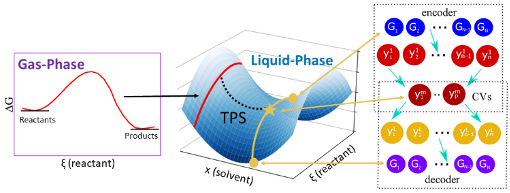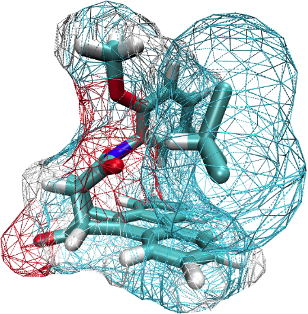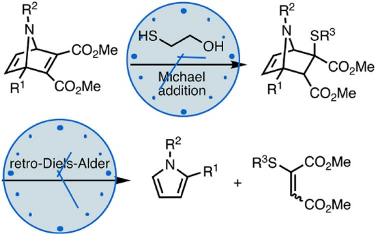Our School sees research as an integral part of its mission towards gaining fundamental and applied knowledge, with the goal of discoveries that benefit humankind and training the next generation workforce. Our gifted undergraduate and graduate students together with postdoctoral research scientists and faculty, drive a plethora of research projects that span not only the full breadth of modern chemistry and biochemistry, but also related disciplines in physics, biology, mathematics, computer science and engineering.
The school’s research is primarily supported with grants and contracts from government and industrial sponsors and through gifts and donations to the Institute and College. In FY20, the school received ~$21 million for sponsored research. Research sponsors not only helped us achieve new discoveries, but also integrate such research efforts into student training and education. As such, our School provides highly interdisciplinary training opportunities for our own undergraduate and graduate students and also, during the summer, undergraduates from other institutions.
Our School is equipped with state-of-the-art instrumentation in the laboratories of individual research groups and also in core facilities. More often than not, teams made up from multiple research groups at Georgia Tech and elsewhere, work together under the umbrella of research centers to answer major scientific questions.
Fundamentals: Building, Studying, and Teaching About Molecules
Theoretical Chemistry

Theoretical Chemistry involves the development of new mathematical models to describe the properties of molecules, using techniques from quantum mechanics, statistical mechanics, and chemical dynamics. These models can be rather complex, and their application to chemical problems may require substantial computer resources. The School of Chemistry and Biochemistry has a strong group of faculty working in the development and application of theoretical chemistry methods. These groups collaborate closely to form a tight-knit theoretical chemistry core that is more than the sum of its parts. Research topics include improved molecular dynamics and Monte Carlo simulations, efficient quantum dynamics techniques, electronic structure methods that yield a deeper understanding of intermolecular forces, and the incorporation of machine learning in theoretical chemistry. Georgia Tech is one of the lead institutions in the development of the open-source electronic structure package Psi (https://psicode.org/). Application areas span many topics ranging from electrochemical energy storage, charge and energy transport in correlated materials, light-matter interactions, and how non-covalent interactions influence drug binding, biomolecular structure, and crystal packing. The School has access to over 44,000 processor cores for demanding simulations, through the Georgia Tech Hive supercomputer (https://www.cc.gatech.edu/news/629130/hive-supercomputer-makes-its-debut) and the Phoenix cluster.
Faculty:
James C Gumbart
molecular dynamics simulations; protein dynamics; membrane proteins; protein synthesis; bacteria-specific systems and processes
Joshua Kretchmer
Theoretical chemistry; quantum dynamics; non-adiabatic dynamics; quantum chemistry; quantum embedding; charge transport; light-matter interactions
Jesse McDaniel
Molecular dynamics, Monte Carlo, quantum chemistry, high-performance computing, electrochemistry, electrochemical energy storage, self-assembly, nanostructured materials, ab initio modeling, machine-learning
David Sherrill
Quantum chemistry; intermolecular forces; theoretical chemistry; algorithms; modeling; machine learning and data generation; software development; high-performance computing
Synthetic Methods and Catalysis

Computational modeling has increasingly become an integral part of many experimental research groups. These groups develop and utilize various computational methods to help guide, analyze, and understand their experiments. Georgia Tech boasts a number of professors who utilize computational modeling in their research. Research areas include bioinformatics, quantum spectroscopy, and liquid- and glassy-state dynamics in complex biological systems
Faculty:
Marcus Cicerone
molecular dynamics simulation to probe intramolecular and intermolecular motion on timescales ranging from MHz to PHz
Robert Dickson
Biological imaging and spectroscopy; metal cluster fluorophores; fluorescent proteins; protein-protein interactions; novel imaging and spectroscopies; optically modulated fluorescence; statistics for multidimensional data analysis; antibacterial sensitivity; in vivo imaging
Carlos Silva
Ultrafast spectroscopy; Multidimensional coherent spectroscopy; quantum spectroscopy; organic semiconductors; conjugated polymers; hybrid organic-inorganic semiconductors; optoelectronics
Synthetic Methods and Catalysis

The preparation of new molecules, macromolecules, and materials lies at the heart of organic and inorganic chemistry, requiring a deep knowledge of synthetic methods, mechanistic understanding, and catalysis. In the molecular realm, our faculty are investigating numerous cutting-edge approaches for a broad array of projects. This includes the development of efficient synthetic methods that enable application across a range of interdisciplinary topics, including biomass upgrading, polymer synthesis, drug development, carbon- and nitrogen-fixation, and electronics applications. Bioactive natural products and small molecules are active targets for therapeutic application. Virus particles are being developed for applications in cell targeting, diagnostics, vaccine development, and materials self-assembly.
Polymer syntheses push the limits of complexity in macromolecular systems using innovative concepts from synthetic organic chemistry, with the design of novel monomers for the construction of functional polyamides, the development of small molecule reagents for the dynamic modulation of branched polymer architectures, and the investigation of new concepts for creating covalent bonds in challenging contexts. Conjugated polymers are being synthesized for both solid state (photovoltaic and charge transport) and redox (electrochromism and electrical charge storage) possibilities.
Transition metal complexes are being prepared in unusual coordination environments and oxidation states. Metal–ligand combinations that undergo reversible low-energy electron transfer can achieve kinetic control over radical reactions, enabling stoichiometric and catalytic processes that are challenging or inaccessible using current methods. Small clusters of low-coordinate late transition metals are designed to achieve difficult bond-forming and bond-breaking processes, to enable new catalytic cycles. Synthetic studies disentangling the complex electronic structure of f-block materials, to elucidate spectroscopic and thermodynamic signatures of electronic structure phenomena unique to lanthanide, actinide, and transuranic materials.
The controlled synthesis and study of nanocrystals builds a scientific base for the large-scale production of nanocrystals with well-controlled compositions, structures, shapes, and other properties sought for applications in areas including optical sensing/imaging, biomedical research, photonics, electronics, and catalysis. The synthesis of transition metal oxides, oxyfluorides, and fluorides enables detailed studies of the role of structural disorder in the response of solid-state materials to temperature and pressure, notably in compounds that shrink on heating (displaying negative thermal expansion).
Research underway concerns the development of metal-specific fluorescent probes for the investigation of the intracellular chemistry of trace elements, the mechanistic study of metalloprotein-catalyzed reactions, as well as the development of protein-based, semi-synthetic organometallic catalysts in aqueous solution.
Laser and Surface Spectroscopy

Utilizing ultrahigh resolution to ultrafast studies, a broad range of researchers develops and applies cutting-edge spectroscopies to understand important chemical systems. Our groundbreaking studies of new materials continue to drive advances in catalysis, fluorescence and chemical imaging, biological dynamics, reduced-dimension nanostructure properties, and molecule-light interactions. These fundamental insights of molecular and nanomaterial behavior inform design of further improved materials tailored to a wide range of applications. The School of Chemistry and Biochemistry has many programs that focus on surface and interface science, aiming to understand the detailed geometric and chemical structures of both “hard” and "soft" surfaces. There is a major emphasis on understanding charge transport and energy exchange under nonthermal, nonequilibrium conditions. The programs focus on energy and environmental/sustainability issues and applications as well as biological and medical application.
Faculty:
Chemical Education

Research efforts in the area of chemistry education in the School of Chemistry and Biochemistry focus on the development and evaluation of student-centered curricula. Faculty in the School incorporate cutting-edge educational technologies to facilitate student learning, develop and implement laboratory experiments with relevance to modern industry and academia, and study the effects of these innovations on student learning.
In response to the COVID-19 pandemic, faculty and graduate students in the First-year Chemistry Program developed a synchronous online delivery (SOD) instructional model for remote laboratories. The SOD model incorporates freely available simulations of chemical phenomena as the basis of data and observations, which students investigate in groups through video-conferencing software. Using a modified version of the Meaningful Learning in Laboratory Instrument (MLLI), we have studied students' expectations and self-reported meaningful learning in this mode of instruction (Jones, Shepler, and Evans 2021). We are also investigating differences in the expectations and experiences of students in a hybrid mode (alternating SOD and in-person experiments) and a fully in-person instructional mode.
Drs. Pamela Pollet and Charlie Liotta have pioneered a new Vertically Integrated Project (VIP) focused on chemistry in flow (ChemFlow). Bringing together an interdisciplinary team of faculty, graduate students, and undergraduates, the ChemFlow VIP team provides students with real-world laboratory and research experience. In 2021, the team reported the reaction of diphenyldiazomethane with benzoic acids in flow and described students-led chemical education research (Pollet et al. 2021) and the transfer of the results to laboratory instruction. This work builds on a model of faculty-guided but independent undergraduate research and co-authorship. The Liotta-Pollet group is one example of the school of Chemistry and Biochemistry efforts to promote an environment in which students learn the importance of teamwork in addressing a research problem and develop important communication and leadership skills – all in an environment that enriches rote learning with the excitement of discovery.
Our faculty also participate in Faculty Learning Communities on campus to share with and learn from the practices and research of colleagues. For example, Dr. Pollet has recently participated in an FLC focused on incorporating positive technologies and approaches from remote instruction into future implementations taught on campus.
Faculty:
Michael Evans
Specifications-based approaches to psychomotor learning in the laboratory; applications of technology in the organic chemistry classroom; self-efficacy and affective learning in the organic chemistry laboratory
Will Howitz
Chemical Biology, Biochemistry, and Immunology

Research in the theme of Chemical Biology, Biochemistry, and Immunology at Georgia Tech’s School of Chemistry and Biochemistry seeks to apply chemical principals to understanding how life works at the molecular, cellular, organismal, and ecosystem levels. Findings here tell us not only how chemical principles dictate the structure and working of life forms, but also lead to translational progress in human and environmental health. Some laboratories in the school are:
The Hud laboratory is investigating how the first biomolecules arose in primordial reaction soups and how and why were these molecules chosen as alphabets around which the language of life developed. The Williams laboratory is studying the evolution of one of the most complex molecular machines- the ribosome. While the function of the ribosome is obligatorily conserved across all domains and strata of life, how this machine has changed over time can tell us about the evolutionary trajectories that other biological systems took and can and perhaps will take in the future. The Peralta-Yahya laboratory uses principles of synthetic biology to create organic molecules using enzymes and cells to compliment traditional organic chemistry schema. The Reddi laboratory takes a close look at how a core nutrient- iron, is trafficked within cells and how iron can expand the capability of biological catalysts to perform challenging reactions. The Lieberman laboratory is developing an atomistic level understanding of how catalysis happens within biological membranes and also how small changes in protein structure underlie various ocular pathologies. The Schmidt-Krey laboratory employs electron microscopy technologies to study the structure and function of membrane proteins. The Oyelere laboratory is at the forefront of designing and crafting small molecules to engage oncological targets and other diseases. The Agarwal laboratory is looking for genetically encoded small molecules that dictate inter-organismal interactions in the oceans.
The School of Chemistry and Biochemistry interacts closely with neighboring research programs in biological sciences and chemical and bioengineering. Our laboratories are performing interdisciplinary and collaborative research which provides a varied and a rigorous training environment for career advancement in the chemical sciences.
Faculty:
Molecular Evolution
Molecular Evolution focuses on uncovering the chemical evolution that led to the origins of life on Earth, retracing the path of biopolymer evolution that gave rise to the complex machinery of extant life, and the use of laboratory methods for the evolution of biological molecules with properties for use in specific applications. The School of Chemistry and Biochemistry has research groups from across the spectrum of subdisciplines that are working on problems associated with the origins of life, these “bottom up” approaches include biochemists focused on the origins of biopolymers, physical and organic chemists focused on uncovering the abiotic reactions and catalysts that were eventually supplanted by enzyme-catalyzed reactions, and analytical chemists that are developing methods for the analysis of the complex mixtures that result from model prebiotic reactions as well as developing equipment to aid the search for life on other planets. Other groups, within the School and across the Georgia Tech campus, are using “top down” approaches (e.g., structural biology, genetics, geology) to understand the historical evolution of life on Earth. Students and postdocs working on these topics benefit by being members of a large and very active community of Astrobiology researchers at Georgia Tech. With an eye towards solving a broader spectrum of biological and biomedical problems, researchers are harnessing the power of directed evolution to develop nucleic acids and proteins with novel properties. These efforts are supported by extensive core facilities within the School and the Petit Institute for Bioengineering and Biosciences.
Finn, Fernandez, Hud, Peralta-Yahya, Williams